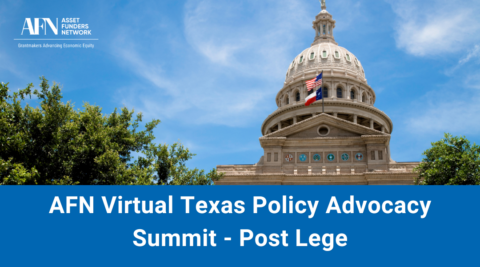
 FROM CHRISTI BAKER, DIRECTOR OF STRATEGIC INITIATIVES, ASSET FUNDERS NETWORK
FROM CHRISTI BAKER, DIRECTOR OF STRATEGIC INITIATIVES, ASSET FUNDERS NETWORK
MARCH 2025
AFN Short Take is a blog series highlighting insights and perspectives from recent AFN programming events.
Climate change is not a distant threat—its impacts are here and accelerating.
The Asset Funders Network (AFN) recently adopted climate as its 8th issue area, a strategic move reflecting a deep understanding that climate change intersects with—and intensifies—each of AFN’s existing priorities to help low- and middle-income households build wealth. From access to stable housing, quality health care, and sustainable employment to repairing the harms caused by historic and ongoing racial discrimination, climate change shapes the terrain funders are working in.
On March 20, AFN launched the first in an ongoing dialogue with philanthropic and community leaders who are demonstrating how funders, regardless of size or strategic focus, can effectively engage in climate-focused work. Featured speakers included:
- Lawrence Bowdish, Lead, Research and Innovation, Wells Fargo
- Patti D’Angelo Juachon, Senior Program Director, Climate Justice Initiative, Marin Community Foundation (CA)
- Gail Latimore, Executive Director, Codman Square Neighborhood Development Corporation (CSNDC) (MA)
- Joe Antolín, President and CEO, Asset Funders Network
What emerged from their conversation was a clear, actionable message: Philanthropy doesn’t have to start from scratch to support climate solutions. It just needs to start from where it already is.
Climate Is Already in the Work You Fund
Climate’s alignment with other strategies is already playing out in a variety of fields. For example, funders supporting affordable housing initiatives are increasingly supporting the integration of solar panels and energy-efficient appliances into renovation projects, reducing utility costs and improving long-term housing stability for renters and homeowners.
In workforce development, training programs for jobs in solar installation, weatherization, and green construction are preparing residents for careers that both pay a living wage and build community resilience. Small business funds are supporting neighborhood entrepreneurs as they retrofit storefronts for energy efficiency or install cooling systems to adapt to rising temperatures.
In health, funders are recognizing the compounding effects of extreme heat, poor air quality, and energy insecurity, especially on seniors and children. Investments in community health centers now often include HVAC upgrades, backup power, and air filtration systems to ensure they remain safe havens during climate emergencies.
“Only the most well-heeled of funding organizations are going to have the capacity to plug in an entirely bespoke climate hazard engagement team,” said Lawrence Bowdish of Wells Fargo. “But you don’t need to be an expert to get engaged in this space. It’s estimated that one in eight homeowners has no insurance, and another one in eight is [underinsured]. If you’re supporting low- and moderate-income communities, you’re already touching climate vulnerability whether you realize it or not.”
” “Our call to action is for funders to think about what they can do that’s aligned next to the grants they’re already doing.” Gail Latimore | Codman Square Neighborhood Development Corporation
Models That Show What’s Possible
The Marin Community Foundation’s journey into climate resilience began not with a strategic plan but with a crisis. In 2019, following catastrophic wildfires in Northern California, Marin County received just two hours’ notice of a region-wide Public Safety Power Shutoff that lasted nearly five days. Seniors were stranded in their homes, families lost food they couldn’t afford to replace, and nonprofit service providers were forced to close their doors. That moment underscored a painful truth: Safety-net nonprofits (including schools and health centers) are on the front lines—whether during personal crises or region-wide emergencies—and these anchor institutions must be able to function during outages and other climate-related impacts.
Determined to change that, the Foundation partnered with Marin Clean Energy (MCE), a local Community Choice Aggregator (CCA). CCAs are an alternative to the investor-owned utility energy supply system in which local entities in the United States aggregate the buying power of individual customers within a defined jurisdiction to secure alternative energy supply contracts. Through this partnership, MCE and the CCA worked to support nonprofits in installing solar and battery storage systems. Ownership of the facilities was key, as was addressing the steep technical and financial barriers these organizations faced. Working together, they helped conduct site assessments, looking at everything from shade levels to battery space. They ultimately launched seven to eight resilience projects that can now operate independently during outages.
COVID-19 delayed installations and strained supply chains, but the Foundation persisted. When the Inflation Reduction Act passed, they leveraged Direct Pay tax credits to bring even more value to these projects.
““The idea of leveraging Direct Pay tax credits through the Inflation Reduction Act dollars adds a layer of complexity to an already technical endeavor. But it, and similarly focused investments, present an incredible opportunity to maximize and increase the cost effectiveness of these projects in a shorter time frame, which we see as being really directly related to building wealth and ensuring the economic security of our communities.”Patti D’Angelo Juachon | Marin Community Foundation
Despite the technical challenges involved in accessing tax credits, whether they’re federal or state, the foundation views them as critical tools for expanding impact and bringing new resources to communities that have historically been left out of clean energy transitions. They’re exploring ways to bundle projects across multiple nonprofits to achieve economies of scale and make these incentives more accessible to smaller organizations.
Climate Justice and Community Development: Lessons from Codman Square
In one of Boston’s most diverse and historically disinvested neighborhoods, Codman Square Neighborhood Development Corporation (CSNDC) in Dorchester, Massachusetts, is showing how climate justice and community development can go hand in hand. With only 30% of households owner-occupied—and the majority of residents being people of color with low to moderate incomes —CSNDC has pioneered community-driven strategies that embed climate action into the everyday priorities of residents: housing, health, transit access, and economic opportunity.
Key initiatives include:
- Home Rehab Energy Ambassador Program: Homeowners receive small grants, ranging from $5,000 to $25,000, for essential home repairs that must include energy efficiency audits and upgrades. In return, recipients become Energy Ambassadors, agreeing to share their experience and knowledge with neighbors for two years. One five-unit condo of residents saw projected savings of 15–30% on heating bills, thanks to simple upgrades like blown-in insulation.
- Transit Justice & Economic Mobility: After 20 years of resident-led advocacy, CSNDC and partners secured $200 million in public investment to restore four Fairmount commuter rail stops that had been removed in the 1970s and convert to electric trains. These new stops now cut commutes from 45 minutes to 15, reduce diesel pollution, and improve access to jobs—transforming a once-polluting rail line into a climate and mobility asset.
- Anti-Displacement Housing: To preempt gentrification pressures from transit improvements, CSNDC and collaborators acquired land near stations and developed 500+ units of affordable, transit-oriented housing—mixed-use “urban villages” that integrate homes and ground-floor commercial space.
- Eco-Innovation District: In a dense, low-canopy neighborhood facing some of Boston’s worst heat and air quality, CSNDC is advancing green infrastructure and urban gardening in the Talbot-Norfolk Triangle, blending environmental improvements with resident priorities like family integration and food access.
By starting there, and supporting resident leadership every step of the way, Codman Square shows how climate strategies can strengthen broader community development goals.
Community organizing is not just a tactic; it’s a core infrastructure for lasting change. “Those of us in the funding community often don’t consider people to be anchor institutions,” said Bowdish. “But in many communities, trusted residents, faith leaders, and grassroots organizers have the credibility and relationships to move action forward faster and more meaningfully than any outside institution.”
A Compelling Vision for Local Leadership and Innovation
Across all of this work is a common thread: climate action rooted in the lived realities of the community. Residents may not engage with climate for its own sake—but they do care about their health, their energy bills, and their children’s futures.
With uncertain prospects for national climate progress, panelists agreed that the most promising opportunities lie at the local level, where philanthropy, public agencies, and communities can respond with agility and collaboration. In Massachusetts, advocates are working to strengthen local funding tools by updating real estate transfer and deed fees, which are currently lower than in neighboring states. Structured progressively, these proposals would generate revenue for environmental resilience and affordable housing without burdening lower-income residents.
As federal support during this time remains uncertain, local governments and place-based funders can help lay the groundwork for future investments and sustain momentum locally. The Marin Community Foundation emphasized that their strongest partnerships are with city and county governments. As a funder rooted in Marin County, they see the lived experience of extreme weather—its impact on safety, mobility, and quality of life—as a constant driver of action.
Panelists also highlighted the value of grantee-led communities of practice—spaces where organizations learn from one another and bridge silos. These networks, often hybrid, help connect otherwise isolated communities and reinforce that sustainable policy solutions grow from the ground up.
“Building readiness—the plans, partnerships, and pipelines needed to move projects from shovel-worthy to shovel-ready—is critical,” said moderator Joe Antolín. This includes ensuring those plans reflect community priorities and the voices of those most impacted. Because most public dollars are limited to implementation, philanthropy has a unique role to play in funding the early-stage work that makes long-term resilience possible.
This is also where patient capital can be transformative. Flexible, longer-term investments, such as revolving loan funds, and program- or mission-related investments, can support projects traditional financing won’t touch, giving communities the time and space to build durable, equitable climate solutions.
For funders looking to explore specific strategies within their existing portfolios, AFN’s new brief, Climate Across AFN’s Issue Areas: Potential Opportunities, outlines intersectional entry points for advancing both economic security and climate resilience, locally and nationally.
This blog is based on insights shared during a recent webinar hosted by the Asset Funders Network.



